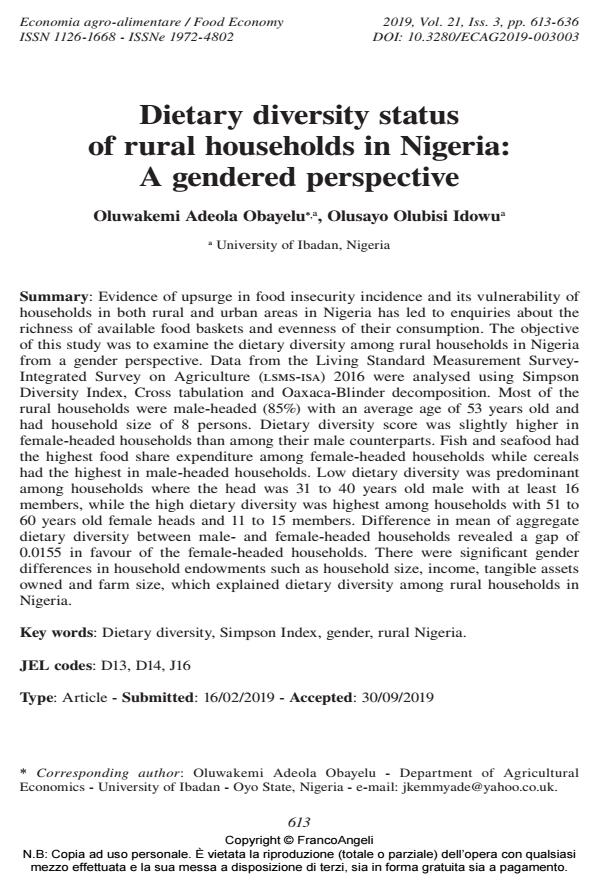Dietary diversity status of rural households in Nigeria: A gendered perspective
Titolo Rivista ECONOMIA AGRO-ALIMENTARE
Autori/Curatori Oluwakemi Adeola Obayelu, Olusayo Olubisi Idowu
Anno di pubblicazione 2020 Fascicolo 2019/3
Lingua Inglese Numero pagine 24 P. 613-636 Dimensione file 301 KB
DOI 10.3280/ECAG2019-003003
Il DOI è il codice a barre della proprietà intellettuale: per saperne di più
clicca qui
Qui sotto puoi vedere in anteprima la prima pagina di questo articolo.
Se questo articolo ti interessa, lo puoi acquistare (e scaricare in formato pdf) seguendo le facili indicazioni per acquistare il download credit. Acquista Download Credits per scaricare questo Articolo in formato PDF

FrancoAngeli è membro della Publishers International Linking Association, Inc (PILA)associazione indipendente e non profit per facilitare (attraverso i servizi tecnologici implementati da CrossRef.org) l’accesso degli studiosi ai contenuti digitali nelle pubblicazioni professionali e scientifiche
Evidence of upsurge in food insecurity incidence and its vulnerability of households in both rural and urban areas in Nigeria has led to enquiries about the richness of available food baskets and evenness of their consumption. The objective of this study was to examine the dietary diversity among rural households in Nigeria from a gender perspective. Data from the Living Standard Measurement Survey- Integrated Survey on Agriculture (lsms-isa) 2016 were analysed using Simpson Diversity Index, Cross tabulation and Oaxaca-Blinder decomposition. Most of the rural households were male-headed (85%) with an average age of 53 years old and had household size of 8 persons. Dietary diversity score was slightly higher in female-headed households than among their male counterparts. Fish and seafood had the highest food share expenditure among female-headed households while cereals had the highest in male-headed households. Low dietary diversity was predominant among households where the head was 31 to 40 years old male with at least 16 members, while the high dietary diversity was highest among households with 51 to 60 years old female heads and 11 to 15 members. Difference in mean of aggregate dietary diversity between male- and female-headed households revealed a gap of 0.0155 in favour of the female-headed households. There were significant gender differences in household endowments such as household size, income, tangible assets owned and farm size, which explained dietary diversity among rural households in Nigeria.
Parole chiave:Dietary diversity, Simpson Index, gender, rural Nigeria.
Jel codes:D13, D14, J16
- Developing Sustainable Food Systems, Policies, and Securities Oluwakemi Adeola Obayelu, Rebecca Funmi Akinmulewo, pp.197 (ISBN:9781799825999)
- A review of gender in agricultural and pastoral livelihoods based on selected countries in west and east Africa Katharine Vincent, in Frontiers in Sustainable Food Systems 908018/2022
DOI: 10.3389/fsufs.2022.908018 - Mapping food accessibility and examining drivers of staple food sources and household food security: insights from Bia West district, Ghana Michael Batame, Rosemary Achentisa Ayelazuno, Isaac Sarfo, Emmanuel Yeboah, in Food Security /2025
DOI: 10.1007/s12571-025-01594-w - Unlocking gender dynamics in food and nutrition security in Ghana: assessing dietary diversity, food security, and crop diversification among cocoa household heads in the Juaboso-Bia cocoa landscape Michael Batame, in BMC Public Health 985/2024
DOI: 10.1186/s12889-024-18204-7
Oluwakemi Adeola Obayelu, Olusayo Olubisi Idowu, Dietary diversity status of rural households in Nigeria: A gendered perspective in "ECONOMIA AGRO-ALIMENTARE" 3/2019, pp 613-636, DOI: 10.3280/ECAG2019-003003